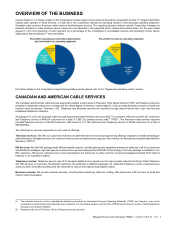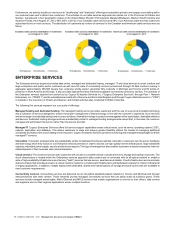Cogeco 2013 Annual Report Download - page 20
Download and view the complete annual report
Please find page 20 of the 2013 Cogeco annual report below. You can navigate through the pages in the report by either clicking on the pages listed below, or by using the keyword search tool below to find specific information within the annual report.
Management's discussion and analysis (“MD&A”) COGECO CABLE INC. 2013 19
Embedded derivatives
Embedded derivatives are separated from the host contract and accounted for separately if the economic characteristics and risks of the host
contract and the embedded derivative are not closely related. A separate instrument with the same terms as the embedded derivative would meet
the definition of a derivative, and the combined instrument is not measured at fair value through profit or loss. At August 31, 2013 and 2012,
embedded derivatives or non-financial derivatives that require separate fair value recognition on the consolidated statements of financial position
were not significant.
CONTINGENCIES AND COMMITMENTS
The Corporation is subject to various claims and contingencies related to lawsuits, taxes and commitments under contractual and other commercial
obligations. The contractual and other commercial obligations primarily relate to network fees and operating lease agreements for use of
transmission facilities. The Corporation recognizes liabilities for contingencies and commitments when a loss is probable and can be reasonably
estimated based on available information. Significant assumption changes as to the likelihood and estimates of a loss could result in the recognition
of an additional liability.
FUTURE ACCOUNTING DEVELOPMENTS IN CANADA
A number of new standards, interpretations and amendments to existing standards were issued by the International Accounting Standard Board
(“IASB”) that are mandatory but not yet effective for the period ended August 31, 2013 and have not been applied in preparing the consolidated
financial statements. The following standards may have a material impact on future consolidated financial statements of the Corporation:
Effective for annual periods
starting on or after
IFRS 7 Financial Instruments: Disclosures January 1, 2013 Early adoption permitted
IFRS 9 Financial Instruments January 1, 2015 Early adoption permitted
IFRS 10 Consolidated Financial Statements January 1, 2013 Early adoption permitted
IFRS 12 Disclosure of Interests in Other Entities January 1, 2013 Early adoption permitted
IFRS 13 Fair Value Measurement January 1, 2013 Early adoption permitted
Amendments to IAS 19 Employee Benefits January 1, 2013 Early adoption permitted
The amendment to IFRS 7 modifies disclosure requirement about all recognized financial instruments that are set off in accordance with IAS 32
Financial Instruments: Presentation
IFRS 9 replaces the guidance in IAS 39 Financial Instruments: Recognition and Measurement on the classification and measurement of financial
assets and financial liabilities. The replacement of IAS 39 is a three-phase project with the objective of improving and simplifying the reporting
for financial instruments. This is the first phase of that project.
IFRS 10 replaces the consolidation requirements in IAS 27 Consolidated and Separate Financial Statements and SIC-12 Consolidation - Special
Purpose Entities. It provides a single model to be applied in the control analysis for all investees.
IFRS 12 establishes disclosure requirements for entities that have interests in subsidiaries, joint arrangements, associates and/or unconsolidated
structures entities.
IFRS 13 replaces the fair value measurement guidance contained in individual IFRS with a single source of fair value measurement guidance.
The standard clarifies the definition of fair value, establishes a framework for measuring fair value and sets out disclosure requirements for fair
value measurements.
The amendments to IAS 19 require the recognition of actuarial gains and losses immediately in OCI, full recognition of past service costs
immediately in profit or loss, recognition of expected return on plan assets in profit or loss to be calculated based on the rate used to discount
the defined benefit obligation and additional disclosures explaining the characteristics of the Corporation's defined benefit pension plans.
The Corporation is in the process of determining the extent of the impact of these standards on its consolidated financial statements.
























